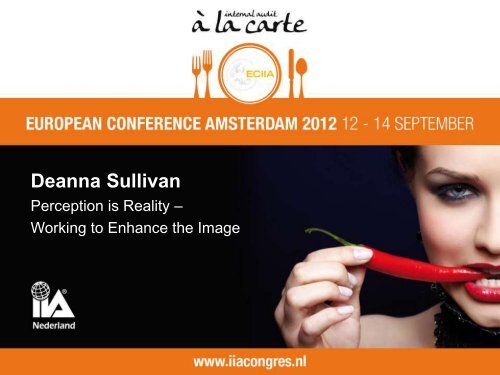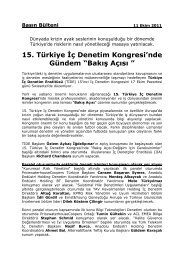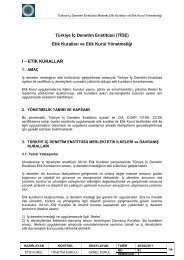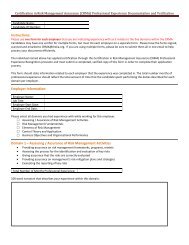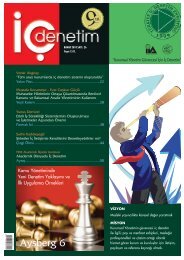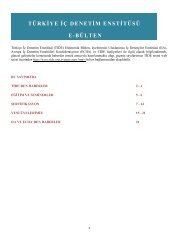Deanna Sullivan - TİDE
Deanna Sullivan - TİDE
Deanna Sullivan - TİDE
Create successful ePaper yourself
Turn your PDF publications into a flip-book with our unique Google optimized e-Paper software.
<strong>Deanna</strong> <strong>Sullivan</strong><br />
Perception is Reality –<br />
Working to Enhance the Image
{Su foto}<br />
<strong>Deanna</strong> <strong>Sullivan</strong><br />
CIA, CPA, CFE<br />
<strong>Sullivan</strong>Solutions<br />
• Founder and Principal of <strong>Sullivan</strong>Solutions<br />
• Delivers coaching and training on risk<br />
management and internal controls;<br />
leadership skills: interpersonal skills;<br />
facilitation and communication skills<br />
• Formerly a partner with Arthur Andersen;<br />
Global Director of Process &Methodology<br />
for their Risk Consulting practice<br />
• Frequent speaker at conferences and<br />
events, including the IIA International<br />
conferences in 2007-2012<br />
• Chair of the 2006 IIA<br />
International Conference<br />
in Houston, Texas
Presentation Overview<br />
• What our clients hear, see, and think<br />
• Why there is a gap in perception<br />
• Strategies for enhancing our image<br />
3
Differences in Perception<br />
We say: “We are going to perform an audit of your area.”<br />
The client hears: ?????<br />
We say: “We are here to help.”<br />
The client hears: ?????<br />
We say: “We have identified some areas for process<br />
improvement.”<br />
The client hears: ? ? ? ? ?<br />
4
Perception Versus Reality<br />
Reality is the state of things as they<br />
actually exist, rather than as they may<br />
appear or may be thought to be.<br />
“Reality is merely an illusion, albeit a<br />
very persistent one.”<br />
– Albert Einstein<br />
5
Perception Versus Reality<br />
The meaning you give to a stimulus you perceive<br />
will fundamentally shape the choices and<br />
actions you take in response to it.<br />
How you analyze what you perceive will be<br />
greatly influenced by many factors, including<br />
your past experiences, feelings, imagination,<br />
values, memories, beliefs and your cultural<br />
setting.<br />
6
Why is There a Difference?<br />
1. Preconceived idea of what Internal Audit is<br />
and does<br />
– What they have heard from others<br />
– What they have experienced in the past<br />
2. No idea of what Internal Audit is and does<br />
3. They don’t trust us because:<br />
– Don’t know us<br />
– Don’t like our personality/behavior<br />
7
Strategies for Enhancing Our Image<br />
• Improving communication by<br />
understanding behavioral styles and how<br />
to adapt<br />
8
Concepts Behind “Styles”<br />
• Styles consist of behaviors<br />
• Everyone is capable of behaving in a range of ways<br />
• Everyone is capable of demonstrating behavior from<br />
each style<br />
• People have preferences in how they interact and want<br />
to be interacted with<br />
• Communication effectiveness is enhanced by<br />
understanding your own style and those of others
Tracom Social Style Model<br />
Assertiveness Dimension<br />
• Is the person more “tell” assertive or more “ask”<br />
assertive?<br />
Responsiveness Dimension<br />
• Is the person more “emote” responsive or more “control”<br />
responsive?
Request<br />
Question<br />
Assertiveness Dimension<br />
Asks Assertiveness Tells<br />
Statements<br />
Demands
Observe the following:<br />
Language<br />
How to Assess<br />
Vocal / tone<br />
Non-verbal<br />
12
Responsiveness Dimension<br />
Controls<br />
Responsiveness<br />
Emotes<br />
Controls<br />
Emotion<br />
Displays<br />
Emotion
Tracom Social Style Model<br />
Controls<br />
Responsiveness<br />
Asks Assertiveness Tells<br />
Emotes
Tracom Social Style Model<br />
Asks<br />
Amiable Style<br />
Emotes
Typical Strengths<br />
• Considerate<br />
• Supportive<br />
• Diplomatic<br />
• Patient<br />
Amiable Social Style<br />
Typical Weaknesses<br />
• Reluctant to speak up<br />
• Can’t or won’t say “no”<br />
• “Beats around the bush”
Tracom Social Style Model<br />
Analytical Style<br />
Asks<br />
Controls
Analytical Social Style<br />
Typical Strengths<br />
• Organized<br />
• Logical<br />
• Foresighted<br />
• Thorough<br />
Typical Weaknesses<br />
• Judgmental<br />
• Too detail-oriented<br />
• Indecisive<br />
• Aloof
Tracom Social Style Model<br />
Controls<br />
Driving Style<br />
Tells
Typical Strengths<br />
• Candid<br />
• Decisive<br />
• Independent<br />
• Efficient<br />
Driving Social Style<br />
Typical Weaknesses<br />
• Bossy<br />
• Uncaring<br />
• Close-minded<br />
• Short-sighted
Tracom Social Style Model<br />
Emotes<br />
Tells<br />
Expressive Style
Expressive Social Style<br />
Typical Strengths<br />
• Energetic<br />
• Enthusiastic<br />
• Outgoing<br />
• Inventive<br />
Typical Weaknesses<br />
• Overwhelming<br />
• Inconsistent<br />
• Impulsive<br />
• Can’t or won’t follow<br />
procedures
Tracom Social Style Model<br />
Controls<br />
Responsiveness<br />
Asks Assertiveness Tells<br />
Emotes<br />
What Style are You?
Styles<br />
–There are no right or wrong styles<br />
–All styles are likely to be represented in<br />
any group—including internal auditors!<br />
–Social styles are based on behaviors.<br />
–We all behave flexibly to some degree.<br />
24
How Versatile Are You?<br />
• Can you adapt your behavior to meet that of<br />
your client? Behavior consists of:<br />
– Language<br />
– Tone/ vocal<br />
– Non-verbal<br />
• Tips for adapting:<br />
– Be aware of your Social Style (SS)<br />
– Be aware of your client’s SS<br />
– Utilize Mirroring Technique<br />
25
Strategies for Enhancing Our Image<br />
• Improving communication by<br />
understanding behavioral styles and how<br />
to adapt<br />
• Watching our words and modifying our<br />
actions<br />
26
Language<br />
When you observe something on an audit, what<br />
words do you use?<br />
a) Observation<br />
b) Issue<br />
c) Finding<br />
The word “finding” indicates<br />
you were looking for something.<br />
And you “found” it.<br />
27
Language<br />
In the audit report, what words do you use<br />
a) We (or “the audit”) discovered<br />
b) We (or “the audit”) noted<br />
c) We (or “the audit”) observed<br />
d) The audit revealed!!!!!<br />
28
Language – Verbal Blind Spots<br />
Verbal Blind Spots (VBS) – spoken behaviors we<br />
either overlook or underestimate their effect.<br />
• Over-promising – failure to achieve the<br />
alignment of word and deed<br />
• Entitlement – using language that intrudes or<br />
condescends<br />
• Them-ing – compartmentalizing people with<br />
labels that limit and divide<br />
29
Strategies for Enhancing Our Image<br />
• Improving communication by<br />
understanding behavioral styles and how<br />
to adapt<br />
• Watching our words and modifying our<br />
actions<br />
• Marketing ourselves<br />
30
Marketing Internal Audit<br />
• Set expectations from the start<br />
• Develop your sales pitch (30-3-30)<br />
• Get to know your client (and their business)<br />
31
A Key to Success<br />
How do you start each audit?<br />
Set Expectations<br />
32
30-3-30 Sales Technique<br />
You have:<br />
To sell what you do<br />
30 Seconds . . . . .<br />
3 Minutes . . . . .<br />
30 Minutes . . . . .<br />
33
A Key to Success<br />
People do business with people they<br />
know and people they trust!<br />
34
How are you getting to know your client?<br />
What are you doing to let them get to<br />
know you?<br />
35
Internal audit by its very nature is in an<br />
adversarial role with the organization.<br />
Learning more about how you are perceived<br />
(verbally and non-verbally) and marketing<br />
yourself and the audit function can help<br />
change your client’s perception.<br />
What are you willing to do to<br />
enhance the image.
Perception or Reality?<br />
What Do You Want Your Client’s<br />
Perception To Be?
Questions?<br />
<strong>Deanna</strong> <strong>Sullivan</strong> CIA, CPA, CFE<br />
deannasullivan@sbcglobal.net<br />
38


